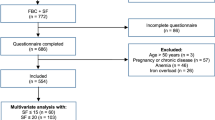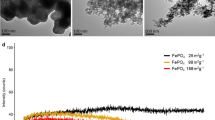Abstract
Background: Iron stores and haemoglobin iron deficits in menstruating women can be calculated from body iron losses and absorption of dietary iron using recently developed methods.
Objective: To examine iron balance (iron status) expressed as body iron stores or haemoglobin iron deficites in menstruating women from amounts of iron lost (iron requirements) and amounts of dietary iron absorbed. Calculations are made both of stationary states and of the rate of changes in iron stores (iron status) when any of the two main factors determining iron balance are changed.
Design: The study is based on (1) previous and new equations describing relationships between iron absorption, iron requirements (losses), iron stores and/or haemoglobin deficits and (2) published data on iron requirements and their variation in menstruating adult women.
Results: Both iron stores and haemoglobin iron deficits are strongly related to iron requirements and absorption of dietary iron and follow the same equations during states of iron repletion and iron deficiency. When, for example, increasing or decreasing the bioavailability of the dietary iron, about 90% of the change in iron stores will occur within 1 y.
Conclusions: There are strong relationships between iron requirements, bioavailability of dietary iron and amounts of stored iron. The observations that a reduction in iron stores and a calculated decrease of haemoglobin iron had the same increasing effect on iron absorption suggest that the control of iron absorption is mediated from a common cell, that may register both size of iron stores and hemoglobin iron deficit, eg the hepatocyte.
Sponsorship: The Swedish Medical Research Council ( project B96-19X-04721-21A), the Swedish Council for Forestry and Agriculture Research (50.0120/95 and 997/881, 113:3), the Swedish Dairy Association and The Danone International Prize for Nutrition 1999 (LH).
European Journal of Clinical Nutrition (2000) 54, 650–657.
This is a preview of subscription content, access via your institution
Access options
Subscribe to this journal
Receive 12 print issues and online access
$259.00 per year
only $21.58 per issue
Buy this article
- Purchase on Springer Link
- Instant access to full article PDF
Prices may be subject to local taxes which are calculated during checkout
Similar content being viewed by others
Author information
Authors and Affiliations
Contributions
Guarantor: L Hallberg.
Contributors: A joint work of all three authors.
Rights and permissions
About this article
Cite this article
Hallberg, L., Hulthén, L. & Garby, L. Iron stores and haemoglobin iron deficits in menstruating women. Calculations based on variations in iron requirements and bioavailability of dietary iron. Eur J Clin Nutr 54, 650–657 (2000). https://doi.org/10.1038/sj.ejcn.1601069
Received:
Revised:
Accepted:
Published:
Issue Date:
DOI: https://doi.org/10.1038/sj.ejcn.1601069
Keywords
This article is cited by
-
The importance of bioavailability of dietary iron in relation to the expected effect from iron fortification
European Journal of Clinical Nutrition (2008)
-
Consequences of iron depletion on health in menstruating women
European Journal of Clinical Nutrition (2003)



